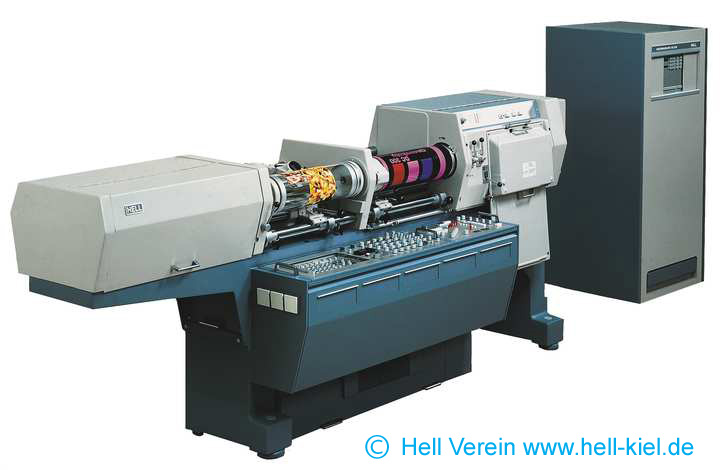Principles of analog scanner
|
The functioning of these non-digital scanners will be explained for the well known Chromagraph DC 300 B as an example (1975). |
||||||
|
||||||
|
is mounted on the scanning drum, and an unexposed black-and-white film is mounted
on the recording drum.
|
||||||
| While the drums are rotat- ing, the picture mounted on the scanning drum is scanned photoelectrically with a scanning unit moving along the scanning drum. In the scanning unit the trans-lucent light resp. reflected light is split into the basic colors red, green, blue by color filters, and these are converted into electrical signals by photomultipliers. Additionally, a surround field signal is generated through an enlarged aperture, which |
 |
|||||
|
is used for sharpening the image signal.These four signals are inputs for
an (analog) color computer, which transforms them into the four color
separation signals yellow, magenta, cyan, black. The color computer has
many different control knobs, which the operator could use to adjust color
corrections for the picture. However, while adjusting the color corrections,
the operator could not see the effect of the corrections (the image was not
stored). Therefore, the operator had to have much experience for adjust-
ing color corrections, since the result became only visible after the picture
was printed.
|
||||||
|
The scanner can change the size of a picture during scanning, i.e. generally
enlarge it. For that purpose the scanner is equipped with a scale computer,
which digitizes and stores the color separation signals during one revolution
of the drum. During the next revolution the digitized signals are read out
again, but for example with a slow-er clock rate, which results in an enlarge-
ment of the picture along the circumference direction. Along the feed direction
the scale change is done by different feeding speeds of the scanning unit
and the recording unit along the drums. The capacity of the memory in the
scale computer was sufficient only for two revolutions, not for the entire picture.
Finally, there is also a screening computer, which transforms the different tone
values of the color separation signals into screen dots of varying size, and
which controls a laser in the recording unit to expose the film on the recording
drum with screen dots of the correct dot size, dot form, screen width, and
screen angle.
Depending on the size of the mounted film and the reproduced size of the
picture, either all four color separations can be exposed on the film side by
side resp. one below the other, or only two separations or only one separation.
In the latter two cases the operator has to repeat the scanning operation twice
resp. four times, and select which color separations to expose.
Such a non-digital scanner performs several steps required for the reproduction
of pictures in one scanning operation, i.e.
- generating color separations for four color printing - color correction - scaling - screening |
||||||

